
How to Use RA-02 SX1278: Examples, Pinouts, and Specs
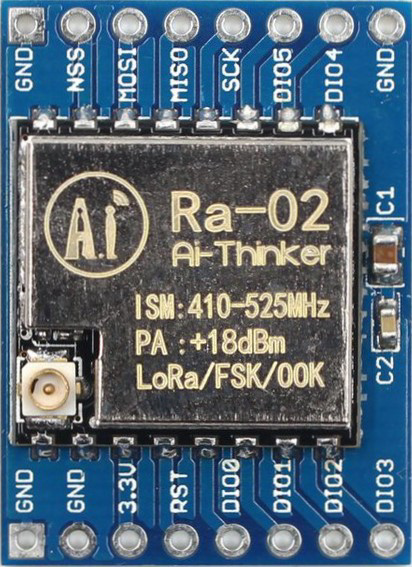
 Design with RA-02 SX1278 in Cirkit Designer
Design with RA-02 SX1278 in Cirkit DesignerIntroduction
The RA-02 SX1278 is a low-power, long-range transceiver module that operates in the 433 MHz frequency band. It is based on the Semtech SX1278 chip and is designed for wireless communication applications. With a high sensitivity of -137 dBm and a range of up to 15 km in open space, the RA-02 is ideal for long-distance data transmission. It supports LoRa (Long Range) modulation, which ensures robust communication even in environments with high interference.
Explore Projects Built with RA-02 SX1278
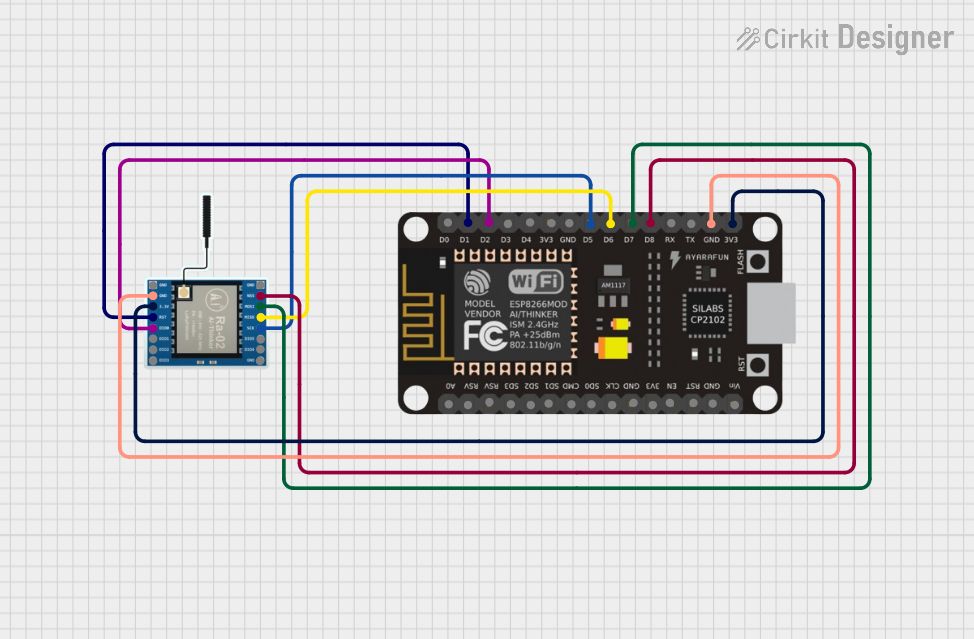
 Open Project in Cirkit Designer
Open Project in Cirkit Designer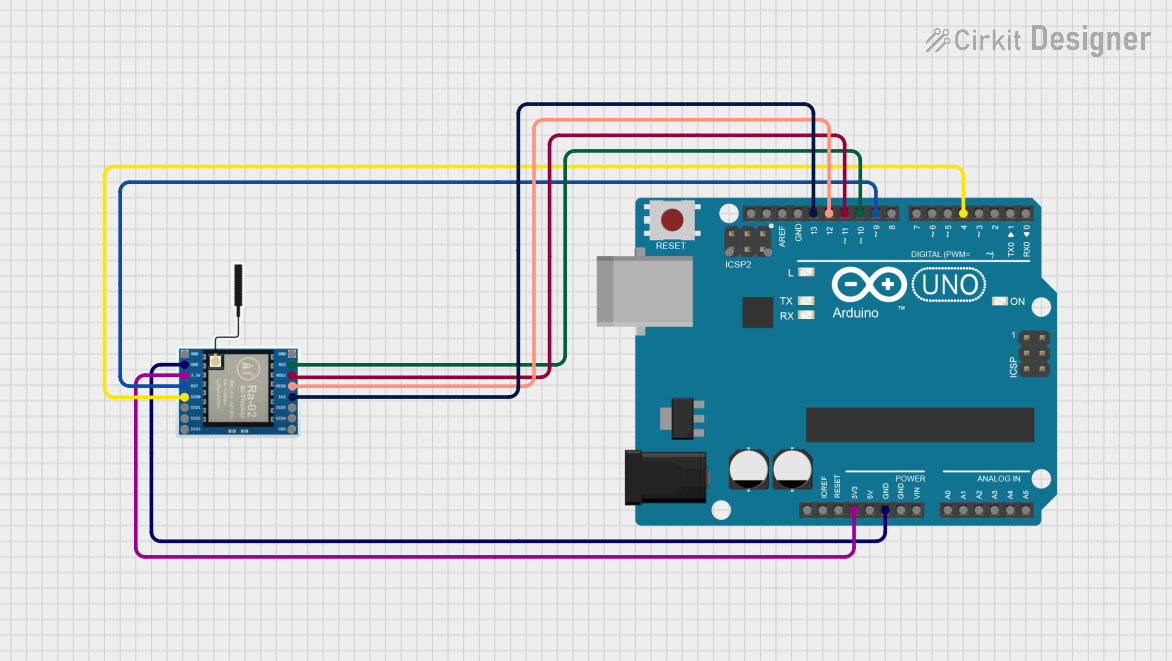
 Open Project in Cirkit Designer
Open Project in Cirkit Designer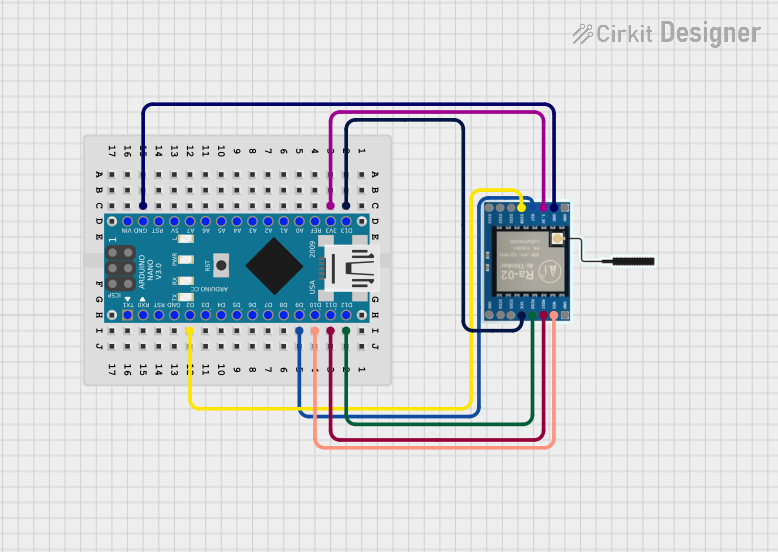
 Open Project in Cirkit Designer
Open Project in Cirkit Designer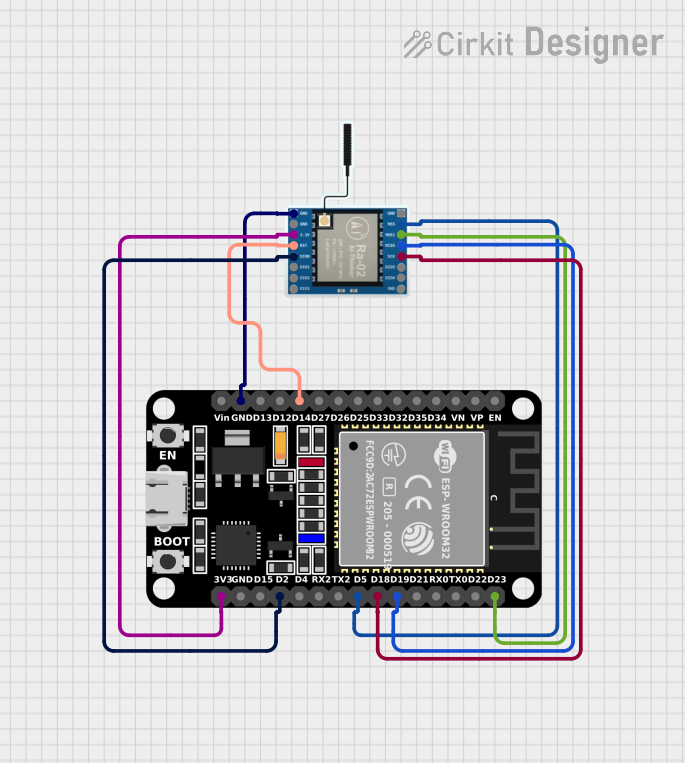
 Open Project in Cirkit Designer
Open Project in Cirkit DesignerExplore Projects Built with RA-02 SX1278

 Open Project in Cirkit Designer
Open Project in Cirkit Designer
 Open Project in Cirkit Designer
Open Project in Cirkit Designer
 Open Project in Cirkit Designer
Open Project in Cirkit Designer
 Open Project in Cirkit Designer
Open Project in Cirkit DesignerCommon Applications and Use Cases
- Internet of Things (IoT) devices
- Remote monitoring and control systems
- Smart agriculture and environmental monitoring
- Home automation
- Wireless sensor networks
- Industrial automation
Technical Specifications
Key Technical Details
| Parameter | Value |
|---|---|
| Frequency Band | 433 MHz |
| Modulation | LoRa, FSK, GFSK, OOK |
| Sensitivity | -137 dBm |
| Maximum Output Power | +20 dBm |
| Communication Range | Up to 15 km (line of sight) |
| Operating Voltage | 1.8V to 3.7V |
| Current Consumption | 10.8 mA (Rx), 120 mA (Tx) |
| Data Rate | 0.018 kbps to 37.5 kbps |
| Operating Temperature | -40°C to +85°C |
| Dimensions | 17 mm x 16 mm x 2.8 mm |
Pin Configuration and Descriptions
The RA-02 SX1278 module has 16 pins. Below is the pinout and description:
| Pin Number | Pin Name | Description |
|---|---|---|
| 1 | GND | Ground connection |
| 2 | DIO5 | Digital I/O pin 5 |
| 3 | DIO4 | Digital I/O pin 4 |
| 4 | DIO3 | Digital I/O pin 3 |
| 5 | DIO2 | Digital I/O pin 2 |
| 6 | DIO1 | Digital I/O pin 1 |
| 7 | DIO0 | Digital I/O pin 0 (used for interrupts) |
| 8 | NSS | Chip Select (active low) |
| 9 | MISO | SPI Master In Slave Out |
| 10 | MOSI | SPI Master Out Slave In |
| 11 | SCK | SPI Clock |
| 12 | GND | Ground connection |
| 13 | 3.3V | Power supply (3.3V) |
| 14 | RESET | Reset pin (active low) |
| 15 | ANT | Antenna connection |
| 16 | GND | Ground connection |
Usage Instructions
How to Use the RA-02 SX1278 in a Circuit
- Power Supply: Connect the
3.3Vpin to a regulated 3.3V power source and theGNDpins to ground. - SPI Communication: Connect the
MISO,MOSI,SCK, andNSSpins to the corresponding SPI pins on your microcontroller. - Antenna: Attach a 433 MHz antenna to the
ANTpin for proper signal transmission and reception. - Interrupts: Use the
DIO0pin for handling interrupts, which are often required for LoRa communication. - Reset: Connect the
RESETpin to a GPIO pin on your microcontroller for resetting the module when needed.
Important Considerations and Best Practices
- Voltage Levels: Ensure that the module operates at 3.3V. Using higher voltages can damage the module.
- Antenna Placement: Place the antenna in an open area, away from metal objects, to maximize range and signal quality.
- SPI Speed: Use an SPI clock speed of up to 10 MHz for reliable communication.
- Decoupling Capacitors: Add decoupling capacitors (e.g., 0.1 µF) near the power pins to reduce noise and improve stability.
- Heat Dissipation: Ensure proper ventilation if the module operates at high power for extended periods.
Example Code for Arduino UNO
Below is an example of how to use the RA-02 SX1278 with an Arduino UNO for basic LoRa communication. This example uses the popular LoRa library.
#include <SPI.h>
#include <LoRa.h>
// Define LoRa module pins
#define NSS 10 // Chip Select
#define RESET 9 // Reset pin
#define DIO0 2 // Interrupt pin
void setup() {
// Initialize serial communication
Serial.begin(9600);
while (!Serial);
Serial.println("Initializing LoRa module...");
// Initialize LoRa module
LoRa.setPins(NSS, RESET, DIO0); // Set module pins
if (!LoRa.begin(433E6)) { // Initialize at 433 MHz
Serial.println("LoRa initialization failed!");
while (1);
}
Serial.println("LoRa initialized successfully!");
}
void loop() {
// Send a test message
Serial.println("Sending message...");
LoRa.beginPacket();
LoRa.print("Hello, LoRa!");
LoRa.endPacket();
delay(5000); // Wait 5 seconds before sending the next message
}
Notes:
- Install the
LoRalibrary in the Arduino IDE before running the code. - Connect the
NSS,RESET, andDIO0pins to the corresponding Arduino pins as defined in the code.
Troubleshooting and FAQs
Common Issues and Solutions
Module Not Responding:
- Cause: Incorrect wiring or power supply.
- Solution: Double-check all connections and ensure the module is powered with 3.3V.
Poor Signal Range:
- Cause: Improper antenna placement or interference.
- Solution: Use a high-quality 433 MHz antenna and place it in an open area, away from obstacles.
LoRa Initialization Fails:
- Cause: Incorrect SPI connections or wrong frequency.
- Solution: Verify the SPI connections and ensure the frequency is set to 433 MHz in the code.
High Power Consumption:
- Cause: Module operating in high-power transmission mode.
- Solution: Use low-power modes when possible and optimize the duty cycle.
FAQs
Q1: Can the RA-02 SX1278 operate at 5V?
A1: No, the module is designed to operate at 3.3V. Using 5V can damage the module.
Q2: What is the maximum data rate supported?
A2: The module supports data rates from 0.018 kbps to 37.5 kbps, depending on the modulation scheme.
Q3: Can I use the RA-02 SX1278 for bidirectional communication?
A3: Yes, the module supports both transmission and reception, making it suitable for bidirectional communication.
Q4: Is the RA-02 SX1278 compatible with other LoRa modules?
A4: Yes, as long as the other modules operate on the same frequency (433 MHz) and use the LoRa protocol.